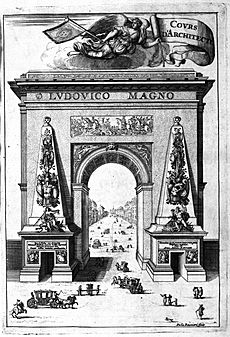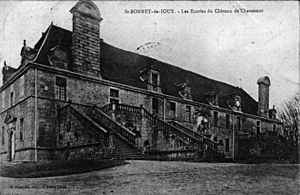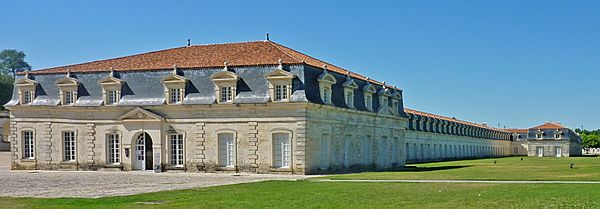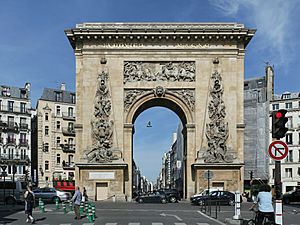François Blondel facts for kids
Quick facts for kids
François Blondel
|
|
|---|---|
| Born |
Nicolas-François Blondel
c. 10 June 1618 |
| Died | 21 January 1686 (aged 67) Paris
|
| Nationality | French |
| Occupation | Architect |
François Blondel (born around 10 June 1618 – died 21 January 1686) was a very talented French person. He was a soldier, an engineer who built forts, a mathematician, a diplomat, and an architect. People sometimes called him "the Great Blondel" to tell him apart from other architects in his family.
He is best known for his book, Cours d'architecture (which means Course in Architecture). This book was very important for over a hundred years. He also wrote other popular books like Cours de Mathématiques (Course in Mathematics) and Art de jetter les Bombes (Art of Throwing Bombs).
Contents
Early Life and Education
François Blondel was born Nicolas-François Blondel in a town called Ribemont in France. He was baptized on June 15, 1618. His father, François-Guillaume Blondel, was a lawyer. His mother, Marie de Louen, came from a local noble family.
Even though his father wasn't born noble, he bought some land nearby. He also served as the mayor of Ribemont many times. Young Nicolas-François learned several languages when he was growing up. He even took part in the Thirty Years' War for a short time.
A Career in Diplomacy and War
In 1640, a powerful leader named Cardinal Richelieu sent Blondel on important trips. He traveled to Portugal, Spain, and Italy. These trips allowed him to study how different countries built their forts.
When he came back from Italy, he knew a lot more about mathematics. He might have even met the famous scientist Galileo during this time. Blondel later said he studied with Galileo himself. He became one of the first people in France to support Galileo's ideas.
Richelieu then made Blondel a sub-lieutenant on one of his ships. He helped attack the port of Tarragona and later became a governor in Palamos. In 1647, Blondel led the artillery (big guns) for a naval attack against the Spanish in Naples. After his military career, he became a high-ranking officer in 1652.
Building Grand Stables
Around 1648, Blondel got his first job as an architect. He designed the huge stables at the Château de Chaumont-la-Guiche. These stables were built between 1648 and 1652. Even though a local builder often gets credit, Blondel wrote that he was the designer.
The ground floor of the stables has three sections with arches. It had room for more than eighty horses. Outside, there are two impressive double staircases. They lead up to a large hall on the top floor. In the middle, above the entrance, there's a life-sized statue of the previous owner on horseback. These grand stables show how important the family was.
Travels and Teaching
In 1652, Blondel became a tutor for the son of a French government official. He took the boy on a "Grand Tour" of Europe. They visited many cities, including Basel, Strasbourg, Vienna, Rome, and Florence. These travels helped him a lot when he wrote his Cours d'Architecture book later. In the 1660s, Blondel went on another tour with the son of Jean Baptiste Colbert, another important French official.
In 1656, Blondel started teaching mathematics and fortification at the Collège de France. He was often away on trips, so another astronomer filled in for him.
From 1657 to 1663, Cardinal Mazarin sent him on more diplomatic trips. He visited Italy, Egypt, Greece, Turkey, Germany, Poland, and even Moscow. During his travels, he met Paul Wurz. Their discussions led to Blondel's first published work, a math paper about how strong beams are. He later wrote more about these ideas in his 1673 book, Résolution des quatre principaux problèmes d'Architecture.
In 1659, while traveling to Constantinople, he saw an amazing aqueduct. He said it was as grand and tall as the famous Pont du Gard. That same year, he became a diplomat in Copenhagen until 1663. Then he was called back to France to become a royal advisor.
Engineer for the King
In 1664, Colbert made Blondel the "King's Engineer for the Navy." This meant he oversaw the building of forts in harbors. He worked in Normandy, Brittany, and the Caribbean islands like Martinique and Guadeloupe. In the Caribbean, he saw a powerful hurricane. This experience gave him ideas for many reports he presented to the Academy of Sciences.
In 1665, Blondel's skills as an architect were tested. He built the royal rope-making factory (called a corderie) in Rochefort. He also supervised the building of a Roman bridge in Saintes.
In 1669, Blondel joined the Académie des Sciences as a geometer (someone who studies shapes and measurements). That year, he visited London and saw an unusual experiment. Scientists tried to cure a madman by giving him a blood transfusion. They thought that feelings could be passed through blood.
Projects in Paris and Teaching Architecture
Also in 1669, Blondel was put in charge of projects to make Paris more beautiful. He helped rebuild the Porte Saint-Denis and the Porte Saint-Bernard, which were grand city gates. He also worked on a plan to expand the city with another architect, Pierre Bullet.
On December 31, 1671, the King made Blondel the Director and Professor of the Académie Royale d'Architecture. This was a very important position.
In 1673, Blondel became the mathematics teacher for the Grand Dauphin, the king's son. Even though the prince wasn't the best student, this project led to Blondel's book, Cours de Mathématiques (1683).
From 1670 until he died in 1686, Blondel was very busy with his work and teaching. He also helped write dictionaries for other scholars.
Images for kids
See also
 In Spanish: François Blondel para niños
In Spanish: François Blondel para niños








